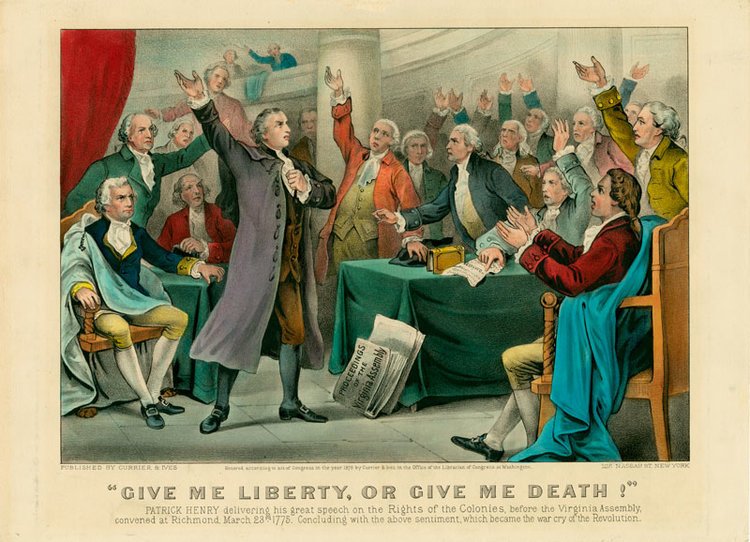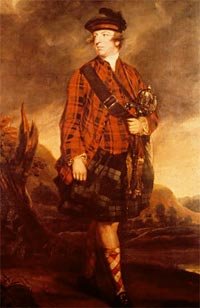
March 20-27, 1775
The Second Virginia Convention
On 20 January 1775, the Virginia Gazette contained a small notice, advising that “The several counties and corporations in this Colony are requested to elect delegates to represent them in Convention who are desired to meet at the Town of Richmond in the County of Henrico, on Monday the 20th of March, next." The second extralegal convention was called by Peyton Randolph to elect delegates to the Second Continental Congress to be held on 10 May 1775.
Lord Dunmore, Royal Governor
Lord Dunmore, the royal governor of the colony, following instructions from the British ministry, had recently published a proclamation notifying the members of the House of Burgesses that they would not convene until May. Dunmore had prorogued, or dismissed, the delegates each time their actions became critical of the British ministry. As a consequence, several laws had lapsed, among them the important act establishing the colonial militia, leaving the colony without forces for frontier defense. Dunmore suspected that the delegates were meeting to form a provincial government and to form a militia. The committee of Fairfax County had passed resolutions on 17 January 1775 recommending that a contribution be collected for the purpose of providing ammunition for the militia. The committee also ordered the militia to assemble and drill, as had a meeting of protectors in Maryland the previous month. The resolution was “the first recorded instance in which a committee not only moved to arm a county but arrogated to itself the power to levy and collect a tax.” The colonial assemblies were unconsciously beginning to take the reigns of government and Dunmore, along with other royal officials, was certainly alarmed.
Attendance at the Second Virginia Convention was high due to the critical state of relations with the mother country and the end of the October 1774 conflict between volunteers from Virginia and Indian tribes in the Ohio Valley, later known as Dunmore’s War. The delegates came and went over the course of the convention, which lasted from Monday, 20 March–Monday, 27 March 1775. On the first day, 20 March, 95 delegates were present and as the days went by and the delegates came and went, the number rose to 120. Seven eligible men were never recorded as present. The convention met in the Henrico Parish Church, now called St. John’s Church.
Peyton Randolph, President of the Second Virginia Convention
On the first day, the delegates elected John Tazewell clerk and Peyton Randolph president. Randolph had been moderator of the first convention, Speaker of the House of Burgesses and president of the First Continental Congress. Randolph brought before the convention the proceedings of the Continental Congress. The convention passed a resolution asking Miles Selden, the rector of Henrico Parish, to read prayers each morning and the delegates agreed to conduct business according to the rules of the House of Burgesses. During the second and third days, the convention discussed the proceedings of the Continental Congress. They passed a resolution approving the proceedings and giving their “warmest Thanks” to the Virginia members, Peyton Randolph, Richard Henry Lee, George Washington, Patrick Henry, Richard Bland, Benjamin Harrison, and Edmund Pendleton.
On the fourth day of the convention, 23 March, Patrick Henry introduced three resolutions.
The first stated
“that a well regulated Militia composed of Gentlemen and Yeomen is the natural Strength and only Security of a free Government: that such a Militia in this Colony would forever render it unnecessary for the Mother Country to keep among us for the purpose of our Defense any standing Army of mercenary Forces, always subversive of the Quiet, and dangerous to the Liberties of the People; and would obviate the Pretext of taxing us for their Support.
His second resolution stated
“that the Establishment of such a Militia is at this Time peculiarly necessary by the State of our Laws for the protection and Defence of the Country, some of which are already expired and others will shortly do so; and that the known Remissness of Government in calling us together in a Legislative Capacity renders it too insecure in this time of Danger and Distress to rely; that Opportunity will be given of renewing them in General Assembly, or making any provision to secure our inestimable Rights & Liberties from those further Violations with which they are threatened.
Henry’s first resolution followed very closely the spirit of the Fairfax County resolutions but did not call for a voluntary contribution to support and supply the militia. By forming a militia that was drilled and prepared, the colonists were taking steps to prevent Britain from maintaining a standing army in their midst and taxing them to support the expense. The second resolution was a sharp condemnation of the royal governor and the King’s ministers who had failed to call the House of Burgesses into session, preventing them from enacting legislation.
Henry’s third resolution was the most provocative:
“Resolved therefore that his Colony be immediately put into a posture of Defence,” that a Committee be appointed “to prepare a Plan for embodying, arming, and disciplining such a Number of Men as may be sufficient for that purpose.”
The third resolution touched off a debate concerning whether it would be seen as a “prophesy of war” and “would place Virginia in the false position of appearing not to resist armed conflict but to invite it.”
Henry rose and delivered the most famous oration of his life in support of his resolutions. His “Liberty or Death” speech was a masterful argument, outlining the interactions between the British ministry and the colonials. Henry began by urging the delegates to examine the past behavior of the ministry and not to cloud their judgment with false hope, declaring, “are we disposed to be of the number of those who, having eyes, see not, and having ears, hear not.” “I am willing to know the whole truth; to know the worst and provide for it.” He argued that the colonials had spent ten years petitioning and pleading with the ministry and Parliament to recognize their rights as Englishmen. He asked the delegates to make their decisions using “the lamp of experience” and stated that there “was no way of judging the future but by the past.” In that light, he concluded, “in vain . . . may we indulge the fond hope of peace and reconciliation.” Henry pleaded with the delegates to recognize that the presence of armies and navies was an act of hostility, not of reconciliation. He warned them that the time for action had arrived, that no matter how weak they perceived themselves to be, they would be even more vulnerable if disarmed and in the presence of the British army. Henry urged the delegates to recognize that “three millions of people armed in the holy cause of liberty, and in such a country as that which we possess, are invincible by any force which our enemy can send against us.” He continued, “gentlemen may cry, peace, peace‚ but there is no peace. The war is actually begun. The next gale that sweeps from the North will bring to our ears the clash of resounding arms!” Henry closed dramatically by invoking the choice that he believed they then had to make, “is life so dear, or peace so sweet, as to be purchased at the price of chains and slavery? Forbid it, Almighty God! I know not what course others may take; but as for me, give me liberty or give me death!”
Henry’s speech was powerful and carried the resolutions in a close vote. The convention journal does not record the actual vote, but Parker wrote that the resolution was “carried by a Majority of 65 to 60.” The convention records indicate that only 118 delegates were likely present that day. The vote was close, and the resolution passed by a narrow margin.
Richard Henry Lee, Westmoreland County
The Outcome of the Second Virginia Convention
Patrick Henry and Richard Henry Lee were named first and second, respectively, in the list of committee members, to propose plans for embodying an army and disciplining the militia. According to parliamentary procedure Henry, having presented the resolution, was named chairman and Lee, who seconded it, was placed next in seniority. Thomas Jefferson supported the resolutions during the debates and was appointed to the committee, as were Andrew Lewis and William Christian (who had gained military experience in Dunmore’s War), and Adam Stephen and George Washington (who were veterans of the French and Indian War). Isaac Zane, who managed an iron works, was also appointed to the committee. And in a departure from standard practice, men who had been skeptical about the wisdom of adopting Henry’s bold resolution were also appointed. The more cautious faction was represented by Robert Carter Nicholas, Lemuel Riddick, Edmund Pendleton, and Benjamin Harrison. The committee members presented their militia plan to the other delegates on the fifth day of the convention, but discussion was postponed until the following day, when it was unanimously agreed to model the current militia after the Militia Law passed in 1738.
The delegates also adopted a resolution thanking the soldiers and Dunmore for their service in Dunmore’s War. The convention reelected the delegates to the Second Continental Congress. The final day of the convention, a committee charged to investigate ways to encourage industry in the colony and to alleviate shortages resulting from the nonimportation agreement reported ways to encourage manufacturing to provide employment and further reduce the colony’s dependence on foreign goods.
In its final acts of business, the delegates to the convention received a report from Robert Carter Nicholas on funds received for the delegates to the First Continental Congress, appointed Thomas Jefferson to serve as a delegate to the Second Continental Congress if Randolph was unable to attend, thanked Miles Selden and the town of Richmond for their hospitality, and requested Alexander Purdie to print the proceedings of the convention.
The convention ended on 27 March and less than a month later on 19 April the first shots of the American Revolution were fired at Lexington and Concord. Henry’s speech was prophetic and has been credited as “the signal utterance of the Revolution, a speech whose eloquent and ringing defense of liberty best expressed the colonials’ emerging will to independence.”
Henry’s phrase, “liberty or death,” became a rallying cry during the Revolution.
Col. George Washington, Fairfax County
Thomas Jefferson, Albemarle County






